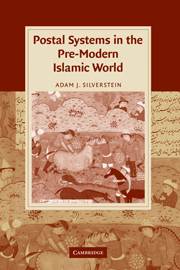Book contents
- Frontmatter
- Contents
- List of maps
- Acknowledgements
- List of abbreviations
- Introduction
- PART I THE PRE-ISLAMIC BACKGROUND
- PART II CONQUEST AND CENTRALISATION – THE ARABS
- PART III CONQUEST AND CENTRALISATION – THE MONGOLS
- Conclusions
- Appendix: distances and speeds of the Barīd
- Bibliography
- Index
- Cambridge Studies in Islamic Civilization
Appendix: distances and speeds of the Barīd
Published online by Cambridge University Press: 18 July 2009
- Frontmatter
- Contents
- List of maps
- Acknowledgements
- List of abbreviations
- Introduction
- PART I THE PRE-ISLAMIC BACKGROUND
- PART II CONQUEST AND CENTRALISATION – THE ARABS
- PART III CONQUEST AND CENTRALISATION – THE MONGOLS
- Conclusions
- Appendix: distances and speeds of the Barīd
- Bibliography
- Index
- Cambridge Studies in Islamic Civilization
Summary
Those using the Barīd (or the Yām) could achieve very impressive speeds. In some cases, the postal speeds recorded in our sources appear to have been exaggerated: neither Faḍl nor Marʾūsh could really have covered over 200 kilometres a day on foot, and al-Ma'mūn could not have instantly received myrobalan fruits from Kabul while campaigning in Byzantine lands. That said, there is usually little reason to dismiss accounts that mention notable rates of travel, especially when various independent sources confirm that a particular speed was achievable. What should be remembered is that, by definition, historians chose to make note only of those speeds that were deemed to be noteworthy, and we cannot draw conclusions about the speeds routinely achieved by a postal system on the basis of such exceptional accounts. Hence, references to the 80 or 85 parasangs that jammāzāt traversed in a 24-hour period during Hishām's reign indicate that it may not have been impossible for mounted couriers to cover some 500 kilometres in a day and a night, but also that we should not expect this to have been a commonplace occurrence.
What speeds can we realistically expect the Barīd and the Yām to have achieved on a regular basis? The Siyāsat al-Mulūk mentions that a mail-bag can travel no more than 60 parasangs (360 kilometres) in a day, while Niẓām al-Mulk states that a network of couriers (paykān) can relay news from 50 parasangs (300 kilometres) away within 24 hours.
- Type
- Chapter
- Information
- Postal Systems in the Pre-Modern Islamic World , pp. 191 - 193Publisher: Cambridge University PressPrint publication year: 2007

